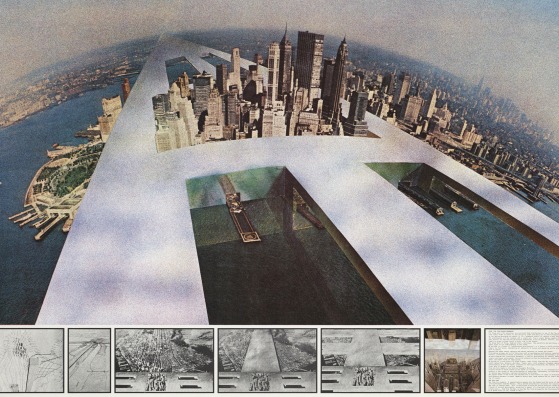Natalini
Adolfo Natalini was born in Pistoia in 1941. After a pictorial experience, which will be reflected in his constant use of drawing, he graduated in architecture in Florence in 1966 and founded Superstudio (with Cristiano Toraldo di Francia, Gian Piero Frassinelli, Roberto and Alessandro Magris, with Alessandro Poli between 1970 and 1972) initiator of the so-called "radical architecture", one of the most significant avant-gardes of the 60s and 70s.
Superstudio's projects (1966-86) have appeared in publications and exhibitions around the world and his works are now part of the collections of museums such as the Museum of Modern Art New York, Israel Museum Jerusalem, Deutsches Architekturtmuseum Frankfurt am Main, Center Pompidou Paris. Among the publications: "Superstudio 1966-82 - Stories Figure Architecture", (Electa Firenze 1982), "Superstudio & Radicals", (Japan Interior Inc. Tokyo 1982), "Superstudio Life without objects" (Skira Milano 2003).
Since 1979 Adolfo Natalini started his own business and focused on the project for historic centers in Italy and Europe, researching the traces that time leaves on objects and places and proposing a reconciliation between collective memory and private memory.
Three of his works: the plans for the Römerberg in Frankfurt and for the Western Wall in Jerusalem, the bank of Alzate Brianza, the Electrocontabile Center of Zola Predosa, the house in Saalgasse in Frankfurt, the Teatro della Compagnia in Florence.
Among the publications: "Stone figures" (Electa 1984), "Adolfo Natalini - Architectures told" (Electa 1989), "The Company Theater" (Anfione Zeto 1989).
Full professor at the Faculty of Architecture of Florence, honorary member of the BDA (Bund Deutscher Architekten) and FAIA (Honorary Fellow American Institute of Architects), academician of the Academy of Arts of Design in Florence, of the Academy of Fine Arts of Carrara and the Accademia di San Luca.
In 1991 he began the activity of the Natalini Architetti (architecture firm at Salviatino, Florence) with Fabrizio Natalini (namesake but not related).
Among their works: the reconstruction of the Waagstraat in Groningen, the Museum of the Opificio delle Pietre Dure in Florence, the Dorotheenhof on the Manetstrasse in Leipzig, the Muzenplein in the Hague, the shopping center of Campi Bisenzio, the University Center in Novoli, Florence, Boscotondo in Helmond, the University Center in Porta Tufi in Siena, Het Eiland in Zwolle, Haverlej in Den Bosch, the Museo dell'Opera del Duomo and the project for the New Uffizi in Florence.
Among the publications: "Construction notes - the Gorle gym" (Il Ferrone 1992), "The Opificio Museum in Florence" (Sillabe 1995), V. Savi "Natalini Architetti - New narrated architectures" (Electa 1996), " De Waagstraat "(Groningen 1996)," Temporary Occupation "(Alinea 2000)," A Sienese building "(Gli Ori 2002), Adolfo" Natalini Architettore "(Fondazione Ragghianti Lucca 2002)," Adolfo Natalini Disegni 1976-2001 "(Federico Motta Editore 2002), "Adolfo Natalini Dutch Album" (AION 2003 editions) "Natalini Architetti" (Brick Building, 97,2004), "Adolfo Natalini Dutch Notebooks" (Aion Edizioni, 2005).
Superstudio's projects (1966-86) have appeared in publications and exhibitions around the world and his works are now part of the collections of museums such as the Museum of Modern Art New York, Israel Museum Jerusalem, Deutsches Architekturtmuseum Frankfurt am Main, Center Pompidou Paris. Among the publications: "Superstudio 1966-82 - Stories Figure Architecture", (Electa Firenze 1982), "Superstudio & Radicals", (Japan Interior Inc. Tokyo 1982), "Superstudio Life without objects" (Skira Milano 2003).
Since 1979 Adolfo Natalini started his own business and focused on the project for historic centers in Italy and Europe, researching the traces that time leaves on objects and places and proposing a reconciliation between collective memory and private memory.
Three of his works: the plans for the Römerberg in Frankfurt and for the Western Wall in Jerusalem, the bank of Alzate Brianza, the Electrocontabile Center of Zola Predosa, the house in Saalgasse in Frankfurt, the Teatro della Compagnia in Florence.
Among the publications: "Stone figures" (Electa 1984), "Adolfo Natalini - Architectures told" (Electa 1989), "The Company Theater" (Anfione Zeto 1989).
Full professor at the Faculty of Architecture of Florence, honorary member of the BDA (Bund Deutscher Architekten) and FAIA (Honorary Fellow American Institute of Architects), academician of the Academy of Arts of Design in Florence, of the Academy of Fine Arts of Carrara and the Accademia di San Luca.
In 1991 he began the activity of the Natalini Architetti (architecture firm at Salviatino, Florence) with Fabrizio Natalini (namesake but not related).
Among their works: the reconstruction of the Waagstraat in Groningen, the Museum of the Opificio delle Pietre Dure in Florence, the Dorotheenhof on the Manetstrasse in Leipzig, the Muzenplein in the Hague, the shopping center of Campi Bisenzio, the University Center in Novoli, Florence, Boscotondo in Helmond, the University Center in Porta Tufi in Siena, Het Eiland in Zwolle, Haverlej in Den Bosch, the Museo dell'Opera del Duomo and the project for the New Uffizi in Florence.
Among the publications: "Construction notes - the Gorle gym" (Il Ferrone 1992), "The Opificio Museum in Florence" (Sillabe 1995), V. Savi "Natalini Architetti - New narrated architectures" (Electa 1996), " De Waagstraat "(Groningen 1996)," Temporary Occupation "(Alinea 2000)," A Sienese building "(Gli Ori 2002), Adolfo" Natalini Architettore "(Fondazione Ragghianti Lucca 2002)," Adolfo Natalini Disegni 1976-2001 "(Federico Motta Editore 2002), "Adolfo Natalini Dutch Album" (AION 2003 editions) "Natalini Architetti" (Brick Building, 97,2004), "Adolfo Natalini Dutch Notebooks" (Aion Edizioni, 2005).
+
-
-
NameAdolfo Natalini







